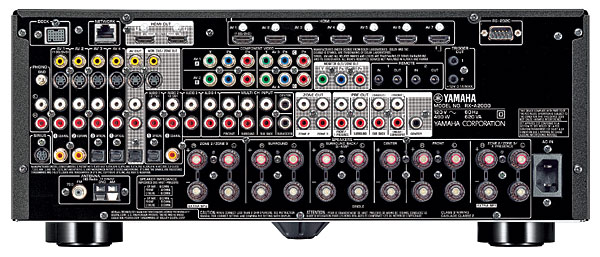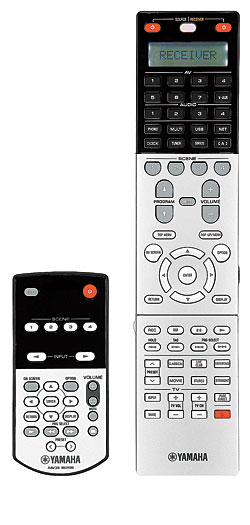Yamaha Aventage RX-A2000 A/V Receiver Page 2

After its initial product announcement, Yamaha added a few more details about the Aventage series, so it’s worth underscoring that these A/V receivers have HDMI version 1.4a so they will be able to switch the signals of 3D formats. In the model under review, that means eight HDMI in and two HDMI out. Also newly provided is compatibility with the Control4 touchscreen control platform.
Fun with Settings
I started YPAO auto setup by selecting “7ch Normal,” which was as close to my 5.1-channel non-biamplified setup as the AVR allowed. YPAO correctly detected that I was using five speakers plus a sub. Like most auto setups, it identified my chunky stand-mount speakers as Large, since they do have moderate bass response. However, for some reason, the Yamaha detected the center speaker as Small, although it was identical to the others. In any case, I wanted to set up all my speakers as Small with a sub crossover of 80 hertz. This required a dive into the Manual Setup menu—which is pretty much standard procedure, by the way, not specifically the fault of YPAO.
 There I found the usual speaker settings and worked my will upon them. Incidentally, Small/80 Hz are Yamaha’s pre-YPAO defaults in Manual Setup, a wise set of choices. I also found something unusual: the Setting Pattern function. It allows you to generate two presets for speaker configuration and calibration. This affords some interesting options. For instance, you might set Pattern 1 as unedited YPAO and do further tweaking on top of YPAO for Pattern 2. Or you might do a full manual setup on Pattern 1 and compare it to YPAO on Pattern 2. You can run YPAO on either pattern or on neither pattern. You can also copy settings from Pattern 1 to 2 or vice versa.
There I found the usual speaker settings and worked my will upon them. Incidentally, Small/80 Hz are Yamaha’s pre-YPAO defaults in Manual Setup, a wise set of choices. I also found something unusual: the Setting Pattern function. It allows you to generate two presets for speaker configuration and calibration. This affords some interesting options. For instance, you might set Pattern 1 as unedited YPAO and do further tweaking on top of YPAO for Pattern 2. Or you might do a full manual setup on Pattern 1 and compare it to YPAO on Pattern 2. You can run YPAO on either pattern or on neither pattern. You can also copy settings from Pattern 1 to 2 or vice versa.
For still broader preset listening convenience, Yamaha provides a dozen Scene functions, which associate an input with numerous other settings. The first four are optimized for Blu-ray or DVD viewing, TV content, CD content, and radio. While you can edit any of them, you might prefer to leave them intact and have your way with the remaining eight Scenes. Each one adjusts a vast array of parameters, notably including Setting Pattern. The others are Input, Audio Select, HDMI Output, Sound Program or Pure Direct Modes, Bass/Treble Control, Adaptive Dynamic Range Control, Compressed Music Enhancer, Cinema DSP 3D Mode (Yamaha’s height mode, with presence speakers), Dialogue Lift, Extended Surround (which extends side-surround effects to back-surround channels), Video Adjustment, Video Processing, Master Volume, Lip Sync, Delay, or Parametric EQ.
Tweakers who like a vigorous A/B session should note that the Pattern and Scene functions are the only methods, albeit indirect, of isolating YPAO and turning it on and off. There’s no dedicated YPAO button on the remote and no other way to select or deselect it in the GUI. You can use the remote’s Pure Direct button to turn off YPAO, but you’ll lose all bass management and other processing with the change.
Associated equipment included five Paradigm Reference Studio 20 v.4 speakers, Seismic 110 sub (with its EQ shut off), and an OPPO BDP-83SE universal disc player. All movie selections were Blu-ray Discs with DTS-HD Master Audio soundtracks.
Straight, Standard, or Pure?
For movie listening, I concentrated on three modes. My primary choice was the Straight mode, which delivered the DTSHD Master Audio soundtracks with bass management but no other processing. I also tried the Standard mode, which (I was told) adds a little Yamaha DSP magic to account for home room acoustics over and above what YPAO already did. I also fooled around with Pure Direct, which strips out all processing including bass management.





























































